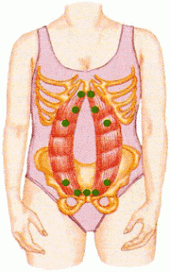Shape Up Saturday: The Core of the Problem
Have you been pregnant? Yes? Cool. This post may be very helpful for recovering from pregnancy, even if it’s been years since you waddled your last waddle. If you haven’t been pregnant, guess what? This post is STILL for you. Don’t run away so quickly.
I’m kicking off my Shape Up Saturday series by talking about our core. This is something I CONSTANTLY talk about in my classes, so I’m sure I have a lot to say, but I’ll keep this as concise as possible.
Okay. So.
Our core can get soft and weak for so many reasons. To name just a few: pregnancy, busy schedules back injuries that require weeks/months of rest, or maybe, just maybe, the computer chair is getting more attention than the yoga mat. Whatever our reason, it’s likely that the weak core will lead to back pain, neck pain, back pain, shoulder/neck pain, back pain, back pain, and other pains. All this pain can lead to damaged vertebrae, tense muscles, and crummy sleep.
And who wants to hurt all the time?
One way we try to fix a weak core is with crunches or sit ups. But if we are pregnant, postnatal, overweight, or even a body builder, we can end up with this:
That’s a Diastasis Recti. This occurs when the rectus abdominis, which is commonly known as the ‘six pack’ that everyone’s always trying to attain, splits. The abdominals as a collective muscle group can’t function well if it maintains this split.
You can determine if you have a split by lying down on your back and with your knees bent. Place your fingertips in the umbilicus and lift your head (not the shoulders) a few times as you press slightly deeper. Feel for the edges of the rectus muscles coming up. The number of fingers that fit in the space between the edges tells you how wide the separation is. A half a finger width indicates no diastasis. A finger or greater indicates there is one.
So what do you do? Suck your stomach in?
Abso-freaking-lutely NOT. Sucking your stomach in restricts your air flow (your diaphragm can’t move around properly in there), your ribcage, shoulders, and neck take on TONS of tension that they just don’t deserve, you don’t engage your deepest (and most helpful) abdominal muscles, the transverse abdominis, and that’s Just. Not Comfortable. Save sucking in your stomach for those 10 uncomfortable seconds you have to squeeze past someone to get to your seat at Thanksgiving dinner.
What you do instead is start by relaxing your stomach, and breathing.
That’s right. Just breathe for a second.
And now take a look at this picture:

A well-explained picture – note the direction each of the muscles move, especially the transverse abdominis.
As I mentioned earlier, the transverse abdominis is the deepest of the abdominal muscles, and can help heal diastasis recti. Below is a simple exercise to heal the split, called transverse pulses.
If you don’t have diastasis recti, this is still an important exercise to use when doing nearly any other exercise, as it will help properly support the spine. Try it and see if you can sense your abdominals better (you should also feel more relaxed!)
Lie on your back with your knees bent and your feet flat on the floor, place your hands on your belly.
- Inhale for 4 counts while letting your belly gently press into your hands.
- Exhale while drawing your belly button slightly in and up to your ribcage (like you’re scooping ice cream), flattening the abdominal wall (TA) and imagining that you are pulling your two sits bones and pubic bone together, squeezing/lifting your pelvic floor muscles.
- Inhale release the muscles half way out
- Exhale and quickly draw them back in
- Quickly repeat this small in and out motion 30 times
- Repeat 2 more sets of the pulses
And that’s it! Sometimes you can’t find that deep awareness of the transverse until you’ve done a set or so. Having a good relationship with our bodies take time and attention, but it’s worth it.
Tell me how you feel after trying this! Also, let me know what part of the body you’d like to strengthen/stretch/relax next.
Posted on September 8, 2013, in Uncategorized and tagged abs, diastasis recti, Pilates, pregnancy, Shape Up Saturday. Bookmark the permalink. 5 Comments.


Definitely using this after this baby comes! And very gently now!
It’s about time someone explained this right. Way to go, Dantzel. Can’t wait to see what else you have coming.
This illustration is amazing. I’ve been looking for something that actually shows me where the tva is.
I’m currently in the throes of closing (lessening?) a diastasis recti and regaining core strength and am blogging my progress. I am going to try to incorporate the exercise you mentioned because I’m running into trouble with even the most basic exercises on the DR recovery program I’m following. So, thank you!
Good luck! Let me know how it goes!
Maybe I’ve been doing it wrong, but I’ve been using a DVD workout specifically for diastasis recti (thanks to a 10 lb. baby!) and I often have difficulty breathing with some of these moves. Definitely giving this a try!